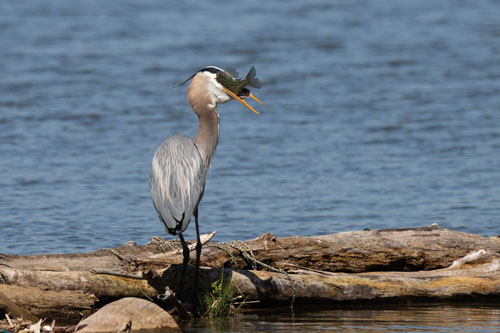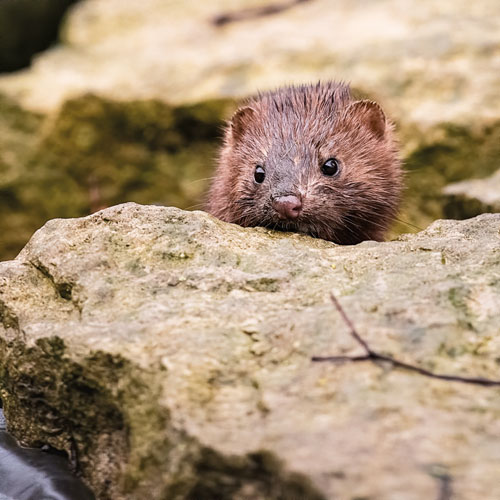About Outdoor Indiana
Outdoor Indiana, the state's premier magazine, delivers the wonders of the Hoosier outdoors to subscribers' homes and offices six times a year in 48 pages of vibrant color. For the best of state parks, lakes, wildlife, forests, trails, hunting, fishing, wildflowers and outdoorsy people, plus inside information from DNR experts, subscribe for $15 per year or $28 for two years. Follow the magazine staff on Facebook.
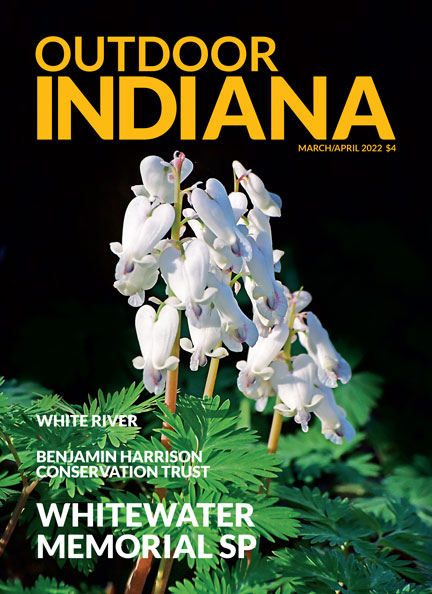
Squirrel corn blooms along Trail 1 at Whitewater Memorial State Park last April.
Featured Stories
- From the director
AIMING TO ECLIPSE YOUR EXPECTATIONS

DNR Director Dan Bortner
Our goal is to ensure that every visit to a DNR property will be a memorable experience for our guests today and for our grandchildren’s grandchildren.
On April 8, 2024, your visit will be out of this world.
That Monday afternoon, a total solar eclipse will arc across the southern half of Indiana, cutting a swath from Vincennes to Union City. The zone of totality, in which it will become almost completely dark, runs through a majority of DNR properties. You can see a map of the eclipse path across Indiana at dnr.IN.gov/places-to-go/events/2024-solar-eclipse.You will soon be able to reserve your place at Abe Martin Lodge, Canyon Inn, Spring Mill Inn, Turkey Run Inn, or Fort Harrison State Park Inn for this once-in-a-lifetime event. Save your spot at dnr.IN.gov/state-parks/inns. Campsite reservations are scheduled to open in 2023. Stay tuned for announcements on eclipse-related packages.
Many properties missing out this time, including Indiana Dunes, Potato Creek, and Pokagon state parks, will be in totality for the next total eclipse in Indiana—September 2099!
We look forward to providing you with outdoor places to gather and watch this eclipse, and the next. Great programs for the weekend before and day of the 2024 event are being planned. If you are a part of an astronomy group or other organization that might be interested in providing volunteers, appropriate viewing equipment, or information as a part of this celebration, please email TotalSolarEclipse2024@dnr.IN.gov.
- WHITEWATER MEMORIAL STATE PARK
Be treated like a local while hiking, camping, and more
By Scott Roberts, OI staff
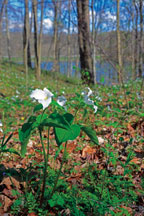
Large-flowered trilliums bloom along Red Springs Loop Trail in Hornbeam Nature Preserve at Whitewater Memorial State Park. (John Maxwell photo)
Sometimes a treasure is hidden right under your nose, but you resist noticing it.
Such was the case for Brian and Michelle Anderson, who live five minutes away from Whitewater Memorial State Park’s entrance, just outside Liberty. For a long time, they wouldn’t go to the local attraction. Too close.“I used to laugh when I’d see people from here who wanted to camp at Whitewater and ask: ‘Why would you want to camp there if you live in the town?’, but now I get it,” Michelle said.
After visiting a few times, the Andersons fell in the love with the facilities. They take their 4-year-old granddaughter to the playgrounds and picnic areas and drive around to view the many scenic highlights. Sometimes they’ll ride their bikes, and sometimes they go fishing. Mostly, they just sit, relax, and enjoy the natural surroundings.
The 1,710-acre park about 50 miles northwest of Cincinnati, just inside the state line, has given Hoosiers that kind of respite ever since its opening 73 years ago. It also attracts residents of three nearby states to its lakes, beach, trails, and other features for fishing, swimming, hiking, camping, birding, and more.
The park offers an intriguing mix of history and nature that begins with its strategic location.
- WHITE RIVER - MAINSTEM PROJECT
Documenting a fish-filled resurrection
By Phil Bloom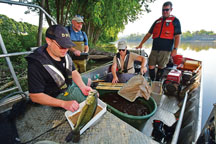
Scientists gather data from White River fish in Indianapolis. The crew consisted of (left to right) DNR biologist Seth Bogue, Muncie biologist Drew Holloway, DNR biologist Sandy Clark-Kolaks, and IDEM environmental scientist Kevin Gaston.
In 1997, the White River that bisects much of central Indiana was singled out as one of the most endangered waterways in the United States.
American Rivers, a conservation advocacy group based in Washington, D.C., included the White on its list that year not because it was one of the nation’s worst or most polluted rivers but because the list’s purpose is to highlight “rivers confronted by critical decisions that will determine their future.”
Two years later, the fear materialized when Guide Corporation, an Anderson manufacturer of automotive headlights and taillights, released toxic waste through the city’s water filtration system into the river. The result wiped out aquatic life in a 40-mile stretch down to Indianapolis.
Fast forward a couple of decades and it appears the river’s status is trending positive for water quality as well as variety and quantity of fish.
A recent multi-agency survey of the river’s west fork from its origins in Randolph County to its mainstem confluence with the Wabash River near Mount Carmel, Illinois sheds light on what’s in the White—from fish species to invertebrates to the habitat and water quality that support them.
“It was an extensive look at the river,” said Sandy Clark-Kolaks, a fish research biologist for the DNR Division of Fish & Wildlife.
Clark-Kolaks represented the DNR in the partnership with Indiana Department of Environmental Management (IDEM) and the Muncie Sanitary District on the survey that they called the White River Mainstem Project.
“This is a first of its kind project,” said Drew Holloway, fisheries biologist with the Muncie Sanitary District, one of the oldest urban water quality and enforcement agencies in the country. “To the best of our knowledge, it is the most comprehensive single-year study for one water body in Indiana history.
“This was a big undertaking and something that without all three of these government organizations working together, there is no way we could have gotten this accomplished.”
For six months in 2020, Clark-Kolaks and Holloway collaborated with IDEM’s Kevin Gaston and a team of nearly two dozen others, covering 362 river miles. They sampled 62 sites, all for fish and aquatic species habitat, most for water chemistry, and a handful for water insects.
- LANDING CONSERVATION PROTECTION
Trusts’ work lasts for perpetuity
By Marty Benson, OI staff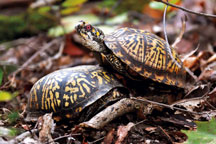
Two Eastern box turtles prepare to mate in the understory of Whistler Hare Woods. The biologically diverse area supports a variety of native plants and animals on the 100-acre tract in Fountain County. (Brent Drinkut photo)
On the north shore of the Ohio River in Harrison County, scenic limestone bluffs rise 150 feet above the water, dramatically marking Indiana’s border. Above those cliffs lie woodlands.
To preserve those features, The Nature Conservancy (TNC), for years, had its eye on acquiring as much of this land as possible.
When an 860-acre parcel became available in 2018, the organization used funding allotted to it from the Bicentennial Nature Trust (BNT) and more from the Benjamin Harrison Conservation Trust (BHCT) to acquire it and transferred a conservation easement on 375 acres to the DNR Division of Nature Preserves last year. TNC acquired the remainder of the tract with private funding.
A conservation easement is a legally binding agreement that limits certain types of uses of a property and prevents development from taking place on it in perpetuity.
BNT was announced in 2012 to celebrate the state’s 2016 bicentennial and was allocated $20 million from state funds and $10 million from the Lilly Endowment. BNT was created to fund conservation-minded projects in partnership with local land trusts, park departments, and other similar organizations, like TNC.
TNC dubbed the combined area Wallier Woods, named for a small cave that is on one of its nearby properties.
The acquisition completed the protection of the 1.3 square miles of forest in Wallier Woods. It also fulfilled the $1 million commitment BNT made to TNC to create the Harrison Glades Bicentennial Conservation Area for which six tracts totaling 322 acres had previously been protected.
Reader Photos
Each issue, Outdoor Indiana staff will select reader submitted photos to feature in the magazine. If you would like the chance to be featured, please submit your photo, along with your name and phone number to:
Please, only submit original photography that you have taken. Do not send files over 9 MB in size. JPG format is preferred.
Subscribe to Outdoor Indiana magazine
Visit the Indiana State Parks online store to subscribe. Cost is $15 for a one year subscription (6 issues) or $28 for two years (12 issues).
Donate
Printing and distribution costs for Outdoor Indiana magazine have increased. One way we’re offsetting these costs is through the Friends of Outdoor Indiana Group administered through the Indiana Natural Resources Foundation. Donations to our friends group helps keep our subscription price low and ensures we’ll be around to bring you the best of Indiana’s outdoors for years to come. Donate at the INRF website and include “Friends of Outdoor Indiana” in the “In Honor Of/In Memory Of” line.
Outdoor Indiana
402 W. Washington St., W255-B
Indianapolis, IN 46204
317-233-3046
OIorders@dnr.IN.gov

